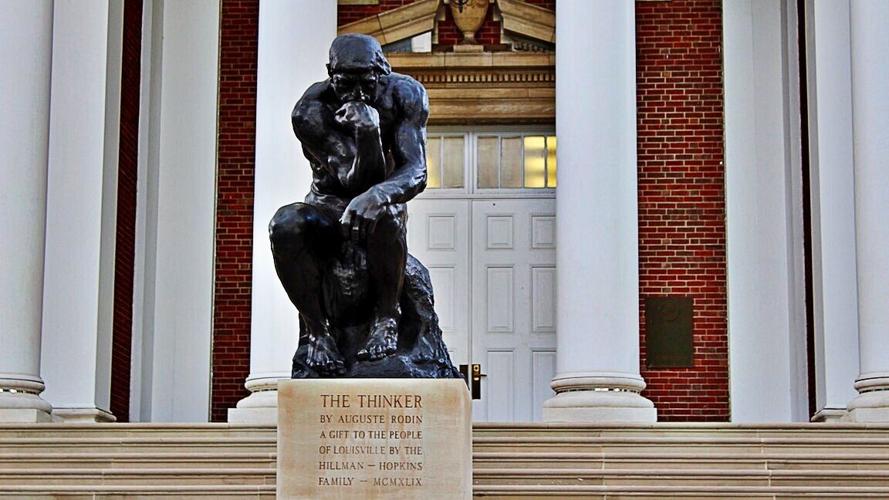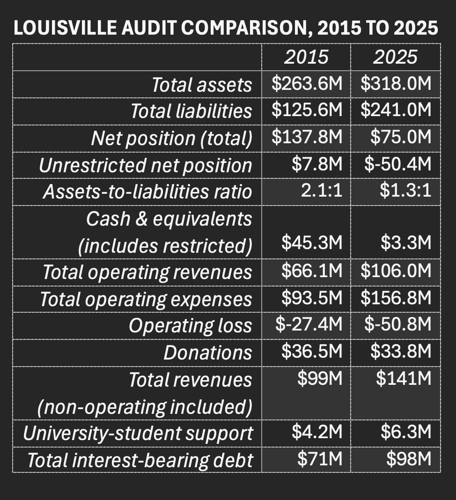LOUISVILLE, Ky. (WDRB) — The books are in order. But the balance is delicate.
The University of Louisville athletic department just received a clean annual audit, presented briskly during a 10-minute athletics board session on Monday. But beneath the surface, the numbers reflect a program walking a much narrower financial tightrope than it was a decade ago.
In 2015, Louisville athletics was winning on the field and thriving off it, highly leveraged, yes, but also flush with donations and strong reserves. The model was growth.
Louisville | Kentucky | Indiana | Eric Crawford
Ten years later, the landscape has shifted. The department has emerged from a tumultuous period with scars. It has endured a pandemic, a lost NCAA championship banner, and endured some stumbles in its most lucrative sports.
Today’s department still operates at a high level, but with thinner reserves, growing debt, and increasing reliance on university subsidies, student fees, and lines of credit.
That’s the picture as it enters the revenue-sharing era of college sports.
Louisville isn’t alone in facing this new reality. But the shift from where it once stood is significant, and the path ahead will demand more discipline than ever.
Then: Growth mindset, winning brand
The 2015 audit reflected an athletic department in expansion mode. The men’s basketball team was still riding the glow of a 2013 national championship. Football had claimed a Sugar Bowl. Women’s basketball and baseball had reached a Final Four and the College World Series, respectively. The brand was hot, the crowds were big, and the money was flowing.

A comparison of athletic audit numbers between 2015 and 2025.
Financially, the department held about $263 million in assets and $125 million in liabilities, for a net position — the difference between what it owned and owed — of $138 million. Its unrestricted reserves were positive ($7.8 million). It had about $45 million in cash on hand and carried roughly $71 million in interest-bearing debt, mostly tied to facilities and capital investments.
Operating expenses outpaced revenues — as they often do in college athletics — but the $27 million operating shortfall was comfortably covered by $36.5 million in donor gifts and other non-operating income. Total revenue landed just shy of $100 million. Support from the university and student fees totaled about $4.2 million, a small slice of the overall budget.
Put simply: Louisville was spending big, but it had room to maneuver. It had cash, reserves, and a winning product to sell.
Now: Bigger budget, thinner cushion
Fast forward to 2025, and the numbers tell a more complicated story.
Louisville’s overall operating revenues have grown to $106 million, and total revenue — including gifts and other outside sources — reached about $141 million.
But expenses have ballooned, too. The department spent roughly $157 million in the audit year, leaving a $50.8 million operating deficit — nearly double what it was in 2015.
Gifts remain strong at $33.8 million, but have not quite returned to their inflation-adjusted level of a decade ago. (Though it’s worth noting, the advent of NIL rules has shifted some donations from university directly to athlete compensation.) Meanwhile, cash reserves have dwindled to just $3.3 million. The unrestricted net position has flipped from positive to negative $50.4 million — meaning available assets no longer cover liabilities.
Debt has also climbed. Interest-bearing obligations — including bonds, notes, internal loans, and a new line of credit— now total close to $98 million. The university approved a $25 million bank credit line, with $8.8 million already drawn as of June 30.
Support from the university and student fees rose to $6.3 million in the audited year. That’s up from 2015, but still modest compared to what’s coming.
A $200-per-student, per-semester fee, plus an increase in the university subsidy, raised the campus contribution to more than $17 million in the current budget.
There’s no financial panic in the report. But the direction is clear: expenses are rising faster than revenues, cash is tight, and the department’s margin for error is much smaller than it once was.
To oversimplify: where Louisville once borrowed to build, it is now borrowing to operate.
The cost of what’s already begun
Importantly, the audit doesn’t include what will likely be the most disruptive expense of all: annual athlete revenue-sharing payments tied to the House v. NCAA legal settlement. Those payments, which began with the current athletic season, are expected to add roughly $20.5 million in new expenses to Louisville’s budget — with more likely as compensation models evolve.
To prepare, the university has already factored that $20 million into future budgets, relying on increased institutional support, student fees, continued donor giving and expanded credit access.
But that means Louisville entered the revenue-sharing era already running an operating deficit in the tens of millions, with far less financial flexibility than it once had.
Perspective and questions ahead
None of this means Louisville athletics is in crisis. It still ranks among the nation’s highest-profile programs. It has donor support. It generates more than $100 million in revenue annually. And it continues to invest in facilities, programs, and coaches at a high level.
But the audit puts numbers to what many have felt: the department is navigating the future from a far more precarious position than it once enjoyed. (A position that is shared by many athletic departments.)
There’s no simple verdict here. The books are balanced. The department remains viable. But the numbers raise unavoidable questions about how to sustain success, how to manage risk, and what it really costs to keep competing at the top level of college sports in 2025 and beyond.
More Sports Coverage:
CRAWFORD | All that's left: Without Bell, Louisville offense will be a thin red line vs. Kentucky
CRAWFORD | Laughing so we don't cry: Setting the stage for Governor's Cup week
CRAWFORD | Brohm owned Louisville's loss at SMU. Owning the offseason will be tougher
Diego Pavia throws for career-high 484 yards as No. 12 Vanderbilt routs Kentucky 45-17
Copyright 2025 WDRB Media. All Rights Reserved.













